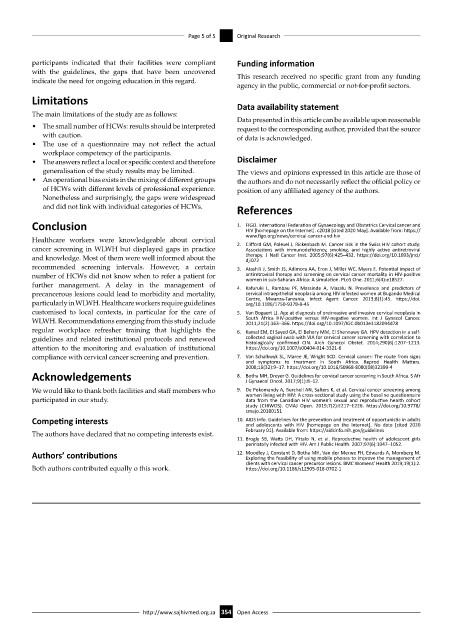Page 362 - HIVMED_v21_i1.indb
P. 362
Page 5 of 5 Original Research
participants indicated that their facilities were compliant Funding information
with the guidelines, the gaps that have been uncovered This research received no specific grant from any funding
indicate the need for ongoing education in this regard.
agency in the public, commercial or not-for-profit sectors.
Limitations
Data availability statement
The main limitations of the study are as follows:
Data presented in this article can be available upon reasonable
• The small number of HCWs: results should be interpreted request to the corresponding author, provided that the source
with caution. of data is acknowledged.
• The use of a questionnaire may not reflect the actual
workplace competency of the participants.
• The answers reflect a local or specific context and therefore Disclaimer
generalisation of the study results may be limited. The views and opinions expressed in this article are those of
• An operational bias exists in the mixing of different groups the authors and do not necessarily reflect the official policy or
of HCWs with different levels of professional experience. position of any affiliated agency of the authors.
Nonetheless and surprisingly, the gaps were widespread
and did not link with individual categories of HCWs. References
Conclusion 1. FIGO. International Federation of Gynaecology and Obstetrics Cervical cancer and
HIV [homepage on the Internet]. c2018 [cited 2020 May]. Available from: https://
www.figo.org/news/cervical-cancer-and-hiv
Healthcare workers were knowledgeable about cervical
cancer screening in WLWH but displayed gaps in practice 2. Clifford GM, Polesel J, Rickenbach M. Cancer risk in the Swiss HIV cohort study:
Associations with immunodeficiency, smoking, and highly active antiretroviral
and knowledge. Most of them were well informed about the therapy. J Natl Cancer Inst. 2005;97(6):425–432. https://doi.org/10.1093/jnci/
dji072
recommended screening intervals. However, a certain 3. Atashili J, Smith JS, Adimora AA, Eron J, Miller WC, Myers E. Potential impact of
number of HCWs did not know when to refer a patient for antiretroviral therapy and screening on cervical cancer mortality in HIV-positive
women in sub-Saharan Africa: A simulation. PLoS One. 2011;6(4):e18527.
further management. A delay in the management of 4. Kafuruki L, Rambau PF, Massinde A, Masalu N. Prevalence and predictors of
precancerous lesions could lead to morbidity and mortality, cervical intraepithelial neoplasia among HIV infected women at Bugando Medical
particularly in WLWH. Healthcare workers require guidelines Centre, Mwanza-Tanzania. Infect Agent Cancer. 2013;8(1):45. https://doi.
org/10.1186/1750-9378-8-45
customised to local contexts, in particular for the care of 5. Van Bogaert LJ. Age at diagnosis of preinvasive and invasive cervical neoplasia in
WLWH. Recommendations emerging from this study include South Africa HIV-positive versus HIV-negative women. Int J Gynecol Cancer.
2011;21(2):363–366. https://doi.org/10.1097/IGC.0b013e3182094d78
regular workplace refresher training that highlights the 6. Kamal EM, El Sayed GA, El Behery MM, El Shennawy GA. HPV detection in a self-
guidelines and related institutional protocols and renewed collected vaginal swab with VIA for cervical cancer screening with correlation to
histologically confirmed CIN. Arch Gynecol Obstet. 2014;290(6):1207–1213.
attention to the monitoring and evaluation of institutional https://doi.org/10.1007/s00404-014-3321-6
compliance with cervical cancer screening and prevention. 7. Van Schalkwyk SL, Maree JE, Wright SCD. Cervical cancer: The route from signs
and symptoms to treatment in South Africa. Reprod Health Matters.
2008;16(32):9–17. https://doi.org/10.1016/S0968-8080(08)32399-4
Acknowledgements 8. Botha MH, Dreyer G. Guidelines for cervical cancer screening in South Africa. S Afr
J Gynaecol Oncol. 2017;9(1):8–12.
We would like to thank both facilities and staff members who 9. De Pokomandy A, Burchell AN, Salters K, et al. Cervical cancer screening among
participated in our study. women living with HIV: A cross-sectional study using the baseline questionnaire
data from the Canadian HIV women’s sexual and reproductive health cohort
study (CHIWOS). CMAJ Open. 2019;7(2):E217–E226. https://doi.org/10.9778/
cmajo.20180151
Competing interests 10. AIDS Info. Guidelines for the prevention and treatment of opportunistic in adults
and adolescents with HIV [homepage on the Internet]. No date [cited 2020
The authors have declared that no competing interests exist. February 01]. Available from: https://aidsinfo.nih.gov/guidelines
11. Brogly SB, Watts DH, Ylitalo N, et al. Reproductive health of adolescent girls
perinatally infected with HIV. Am J Public Health. 2007;97(6):1047–1052.
Authors’ contributions 12. Moodley J, Constant D, Botha MH, Van der Merwe FH, Edwards A, Momberg M.
Exploring the feasibility of using mobile phones to improve the management of
clients with cervical cancer precursor lesions. BMC Womens’ Health 2019;19(1):2.
Both authors contributed equally o this work. https://doi.org/10.1186/s12905-018-0702-1
http://www.sajhivmed.org.za 354 Open Access

